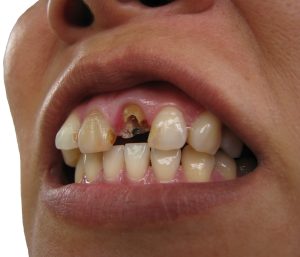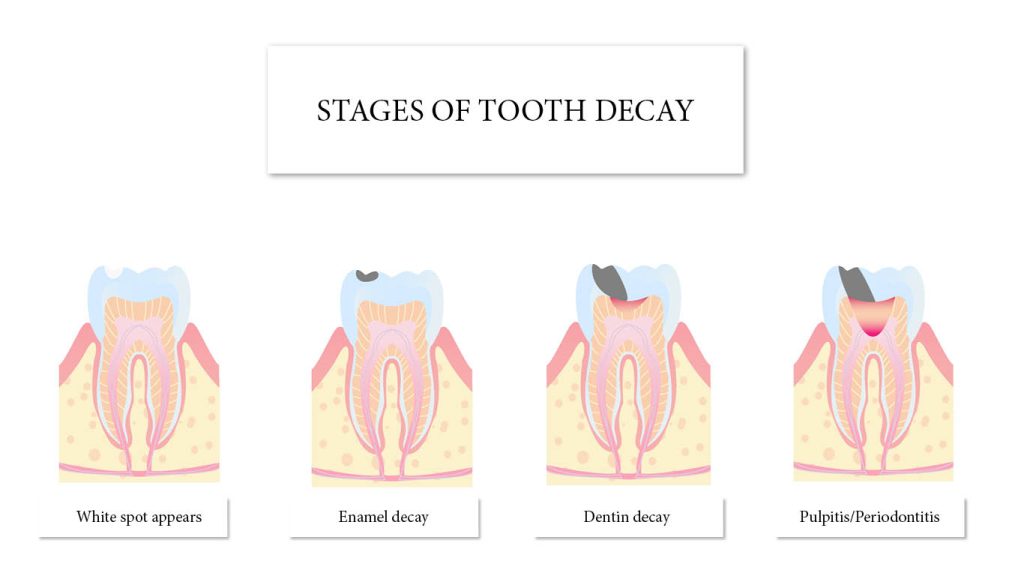If you've ever wondered about the early signs of dental cavities, you're not alone. Maintaining good oral health is crucial, and part of that involves knowing what to look for when it comes to dental issues.
In this comprehensive guide, we'll answer the question: “What does a cavity look like?” And we'll have a look a cavities at different stages so you know what to look for.
A quick look! | |
  Advanced cavity on front teeth |   Early-mid stage cavities on the molars |
In This Article
What does a cavity look like in the early stages?
In the early stages, a cavity might look like a small brown stain or spot. It can be especially difficult to see with the naked eye if the cavity is beginning in the crevices of your molars.
However, understanding what to look for can help you take action before the problem worsens.
- Appearance: In the very early stages, a cavity might appear as a small white or chalky spot on the tooth's surface. This spot could be barely noticeable, especially to the untrained eye.
- Location: Cavities can form on any tooth surface, including molars and front teeth. They can also develop between teeth, where it's more challenging to spot them without dental X-rays.
- Texture: Early cavities may feel slightly rough when you run your tongue over them. They might be subtle, but they can progress quickly if not addressed.
Cavities often form without causing pain initially, leading many to delay dental visits until symptoms arise. Regular check-ups and good oral hygiene can prevent many dental issues, yet cavities may still develop due to factors like dry mouth, health conditions, and genetics. Without treatment, cavities can worsen, causing pain and sensitivity, and may require more complex procedures like root canals, crowns, or extractions.
Tooth pain should prompt immediate dental consultation to address potential cavities or other oral health problems. Untreated cavities can reach the tooth's inner layer, causing severe pain and potentially leading to infections that risk spreading beyond the mouth, impacting overall health.
Dr. Andres Gonzalez, Symphony Dental Studio
What does a cavity look like on an X-ray?
On an x-ray, cavities look like a dark, shadowy spot on the tooth, indicating an area of decay. Dentists often use X-rays to detect cavities that aren't visible to the naked eye. These X-rays are an invaluable tool for dentists to assess the extent of the damage and formulate a treatment plan.
What does a cavity filling look like?
When a cavity progresses beyond its initial stages, it might require a dental filling. So what does a cavity filling look like? They can be metal, or made from porcelain or composite resin, in which case they would be virtually invisible. If a cavity is filled with a tooth-colored material, it becomes nearly indistinguishable from the surrounding tooth structure.
What does a bad cavity look like?


A bad cavity can look like a pit or hole on the surface of your teeth. It can also be black or brown in color. As cavities progress, they become more noticeable and potentially more troublesome. Understanding the stages of cavity development can help you recognize when it's time to seek dental care.
- Early Stages: In the early stages, a cavity might be limited to a small, white, or chalky spot on the tooth's surface. At this point, it's often painless and easily treatable with proper oral care.
- Moderate Stages: As a cavity progresses, it may evolve into a darker, discolored area on the tooth's surface. You might start to experience sensitivity to hot or cold foods and beverages. At this stage, dental intervention is essential to prevent further damage.
- Advanced Stages: When a cavity reaches an advanced stage, it can manifest as a dark hole or pit on the tooth's surface. It may cause persistent pain, especially when eating or drinking. If left untreated, advanced cavities can lead to more significant dental problems, such as infections or abscesses.


Tips for Cavity Prevention and Maintenance
To avoid cavities and maintain excellent oral health, it's crucial to practice good oral hygiene. Here are some key preventive measures:
- Regular brushing and flossing: Brush your teeth at least twice a day with fluoride toothpaste and floss daily to remove food particles and plaque.
- Dental check-ups: Visit your dentist regularly for check-ups and professional cleanings. These appointments can help detect cavities in their early stages and address them promptly.
- Balanced diet: Limit sugary and acidic foods and beverages, as they can contribute to cavity formation. A diet rich in fruits, vegetables, and dairy products can promote healthy teeth.
- Fluoride treatments: Consider fluoride treatments, especially if you're at a higher risk of developing cavities. Fluoride helps strengthen tooth enamel and can prevent decay.
- Dental sealants: Dental sealants are a protective coating applied to the chewing surfaces of molars to prevent cavity formation in the crevices.
Find out how to remineralize enamel, and read more about tooth decay.
Dental caries in the permanent teeth
A study on dental caries reveals important insights into the prevalence, unmet needs, and severity of tooth decay in adults:
- Nearly 90% of adults aged 20 to 64 have experienced tooth decay, a percentage that has remained stable over the years.
- Adults aged 50 to 64 show the highest prevalence of decay, with 96% affected.
- Smoking is linked to higher decay prevalence.
- While there was a slight decrease in decay prevalence among younger adults, significant disparities persist among different population groups.
Unmet needs
- 1 in 4 adults aged 20 to 64 have untreated decay.
- Disparities exist, with younger adults, those with lower incomes and education levels, and current smokers more likely to have untreated decay.
Severity
- In 2011–2016, adults aged 20 to 64 had an average of 9.3 decayed, missing, or filled teeth.
- Disparities in decay severity persist among various population groups.
The Impact of dental cavities on oral health
Beyond understanding what cavities look like, it's essential to grasp the broader implications of untreated tooth decay on oral health. Cavities, if left untreated, can lead to a cascade of dental problems:
- Tooth sensitivity: As a cavity progresses, it can erode the protective enamel, leading to increased sensitivity to hot, cold, sweet, or acidic foods and beverages. This tooth sensitivity can significantly affect your daily comfort.
- Toothache and pain: Advanced cavities can cause persistent toothaches, often triggered by the pressure of chewing or exposure to temperature extremes. These pains can be severe and disruptive.
- Tooth infections and abscesses: When the decay reaches the inner pulp of the tooth, it can lead to infections. Dental abscesses, characterized by severe pain, swelling, and pus formation, can result from untreated cavities.
- Tooth loss: In the worst-case scenarios, extensive cavities can lead to tooth loss. Losing a tooth can affect your ability to chew properly and may lead to misalignment in your bite.
- Spread of infection: Untreated dental infections can spread to other parts of the face and head, causing more severe health issues. In rare cases, untreated infections have been linked to conditions such as Ludwig's Angina, a potentially life-threatening condition.
- Costly dental procedures: Ignoring cavities can result in more extensive and expensive dental treatments, such as root canals or extractions. Preventive care and early intervention are far more cost-effective.
The connection between cavities and overall health
It's not just your oral health at stake when you neglect cavities. Research has long shown a link between oral health and overall health. Untreated cavities can contribute to systemic health issues:
- Heart Disease: Some studies have explored a potential link between gum disease (which can be exacerbated by untreated cavities) and heart disease. While the connection isn't fully understood, maintaining good oral health remains essential.
- Diabetes: Emerging research indicates that oral health problems, including cavities, may affect blood sugar control in people with diabetes. Managing oral health can be a crucial aspect of diabetes care.
- Respiratory Infections: Poor oral health, including untreated cavities, can lead to respiratory issues. Aspiration of bacteria from the mouth can contribute to pneumonia and other respiratory infections.
- Pregnancy Complications: Pregnant individuals with untreated cavities may face an increased risk of complications, including preterm birth and low birth weight. Proper oral care is vital during pregnancy.
Read more about it in this article from the New York Times.
Oral health can have an important impact on your mental health, and oral hygiene, oral health and self-esteem are also closely related.
Conclusion
Understanding what a cavity looks like in its various stages is essential for maintaining optimal dental health. Early detection and preventive measures can help you avoid the discomfort and expense associated with advanced cavities.
Remember to consult your dentist for personalized guidance on cavity prevention and treatment. With the knowledge of what to look for and a commitment to good oral hygiene, you can keep your smile healthy and bright for years to come.
FAQs
What Does a Cavity Look Like on a Front Tooth?
A cavity on a front tooth might initially appear as a small, discolored spot, often white or chalky. It can progress to a darker, more noticeable lesion if left untreated.
What Does a Cavity Look Like in an X-ray?
On an X-ray, a cavity shows up as a dark, shadowy area on the tooth, indicating decay. Dentists rely on X-rays to assess the extent of the damage and determine the appropriate treatment.
What Does a Cavity Look Like on Molars?
Cavities on molars can vary in appearance but often start as small, chalky spots that become more noticeable as they progress. Molars are particularly susceptible to cavities due to their intricate chewing surfaces.
NIH: The Connection Between Oral Health and Overall Health and Well-Being. Consulted 9th October 2023.
NIH: Dental Caries (Tooth Decay) in Adults (Ages 20 to 64 Years). Consulted 9th October 2023.
Nytimes.com: Why Oral Hygiene Is Crucial to Your Overall Health. Consulted 9th October 2023.




